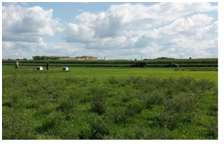| Alfalfa Selfing Management |

|

Selfing rate in alfalfa seed-production fields
Alfalfa is the most important forage crop in the US. Alfalfa is a known outcrosser although individuals and fields vary in selfing rate. Selfing can lead to severe inbreeding depression and reduced seed and hay yields. We detected significant variation in selfing rate (0- 52%) among plants in alfalfa seed-production fields pollinated by leafcutting bees (Riday et al. 2015, Crop Science).
We have since estimated selfing rate in 32 alfalfa seed-production fields over the Pacific Northwest, the Central and the Imperial Valleys of California (Dieterich Mabin et al. 2021, Frontiers in Plant Science). We found no difference in average selfing rate among these regions and an average selfing rate of around 12.2%. We observed an excess of heterozygotes in both parents and progeny. We detected significant and similar levels of inbreeding depression in both the parents (0.231) and the progeny (0.229). There was a 15% decrease in the number of seeds per stem and 13% in the number of seeds per pod in the selfed relative to the outcrossed stems. By outcross here we mean that seeds were sired by pollen coming from other plants in the field. Results of this study indicate that most of the selfing in alfalfa seed production fields is pollinator-mediated and occurs because of pollen being moved by bees among flowers on the same stem, a form of selfing called geitonogamous selfing. Therefore, increasing pollinator abundance in alfalfa seed production field will not decrease selfing.
We are currently examining how pollination management practices and other management practices affect the selfing rate in alfalfa seed production fields.

